Lincoln Tech Bundle
Can Lincoln Tech Continue Its Ascent in Technical Education?
From its humble beginnings in 1946, Lincoln Tech has evolved into a leading provider of career training programs across the United States. With a focus on technical education, the company has consistently adapted to meet the changing demands of the workforce. This analysis delves into Lincoln Tech's growth strategy and future prospects, exploring its market position and expansion plans.
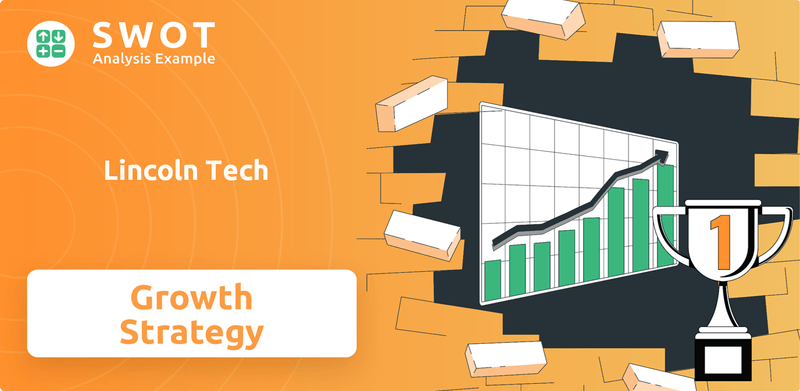
Lincoln Educational Services is experiencing significant growth, with a 16.2% year-over-year revenue increase in Q1 2025, reaching $117.5 million, and a student population of 15,469. This success is fueled by its strategic alignment with the needs of the middle-skill job market and its commitment to providing high-quality vocational schools. To understand the company's trajectory, explore the Lincoln Tech SWOT Analysis for a comprehensive view of its strengths, weaknesses, opportunities, and threats.
How Is Lincoln Tech Expanding Its Reach?
The growth strategy of Lincoln Tech, also known as Lincoln Educational Services, centers on a dual approach of organic expansion and potential acquisitions. This strategy is designed to enhance its market presence and capitalize on the increasing demand for skilled labor. The company's focus on expanding its campus network and diversifying its program offerings is a key element of its future prospects.
A significant component of this strategy involves the strategic placement of new campuses in high-demand markets. The company aims to meet the needs of students and employers by offering career training programs in areas with significant job growth. These initiatives are supported by the company's financial performance and its ability to adapt to industry changes.
The company's hybrid learning model, Lincoln 10.0, is central to these expansion efforts, as it expands capacity at existing campuses and generates instructional cost savings, with a goal to serve 80% of students by mid-2026.
The company opened a new campus in East Point, Atlanta, in March 2024, which became profitable ahead of schedule. Additional campuses are planned for Houston, TX (Q4 2025), and Hicksville, NY (Q4 2026). New campuses are projected to generate approximately $6 million in EBITDA within 36 months of opening, demonstrating a strong financial outlook.
Lincoln Tech is relocating and expanding its Nashville, TN, and Philadelphia, PA (to Levittown, PA), campuses. The Nashville facility is set to open its first welding class in early 2025 in its new location. The Levittown campus is expected to open in Q1 2025, further strengthening its presence in key markets.
In 2024, Lincoln Tech launched five new programs and plans to replicate seven more in 2025. This strategy aims to expand capacity and diversify revenue streams. The focus is on offering in-demand training, such as electrical and HVAC, to meet the needs of the future job market.
Strategic corporate partnerships are crucial for enhancing training programs and revenue. Collaborations with companies like Hyundai, Tesla, and Container Maintenance Corporation support the company's mission. These partnerships help ensure that training programs align with industry needs and create opportunities for students.
The company's expansion plans are focused on strategic growth, including new campuses and program replication. This approach is designed to meet market demands and generate strong financial returns. To learn more about the company's core values, read Mission, Vision & Core Values of Lincoln Tech.
- New Campuses: Houston (Q4 2025), Hicksville (Q4 2026).
- Campus Relocations: Nashville, TN, and Philadelphia, PA (to Levittown, PA).
- Program Replication: Seven more programs in 2025.
- Hybrid Learning: Lincoln 10.0 to serve 80% of students by mid-2026.
Lincoln Tech SWOT Analysis
- Complete SWOT Breakdown
- Fully Customizable
- Editable in Excel & Word
- Professional Formatting
- Investor-Ready Format
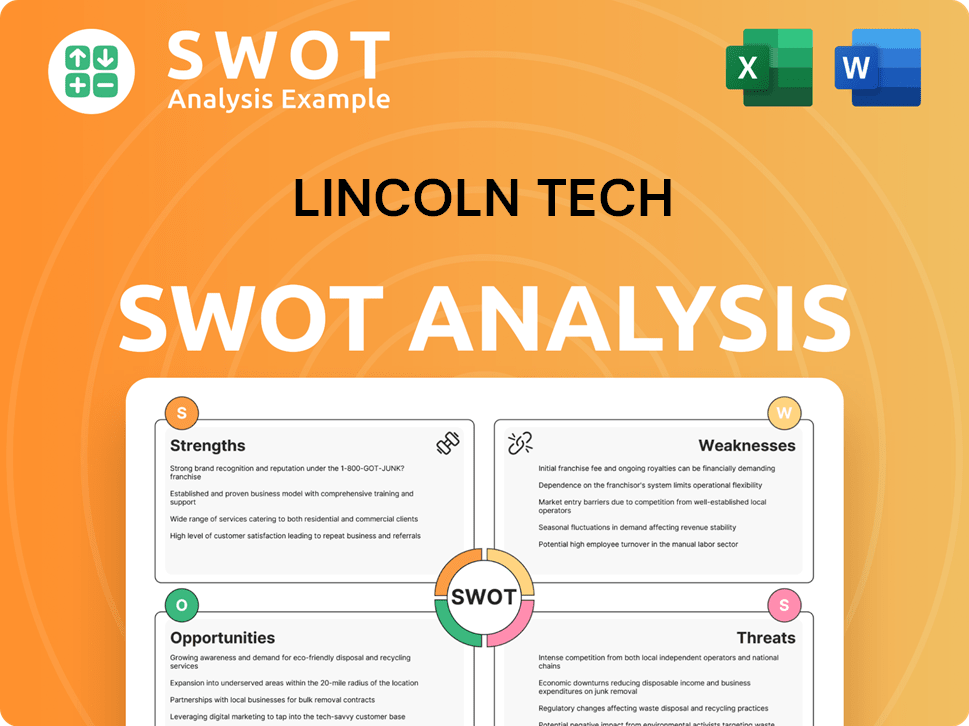
How Does Lincoln Tech Invest in Innovation?
The innovation and technology strategy of Lincoln Tech, a key component of its Lincoln Tech growth strategy, focuses on leveraging technology to enhance the student experience and drive operational efficiencies. This approach is central to the company's Lincoln Tech future prospects, ensuring it remains competitive in the technical education sector. The company's commitment to integrating cutting-edge technologies into its curriculum is a key element of its long-term goals.
A primary example of this strategy is the 'Lincoln 10.0' hybrid instructional platform. This platform is designed to improve student retention and streamline program delivery. The full transition to this platform is expected by the end of 2025, which is anticipated to significantly impact the company's operational performance. This platform increases program efficiency and delivers accelerated revenue recognition in certain evening programs, contributing to operational efficiencies.
Furthermore, Lincoln Tech has achieved improved marketing efficiencies, resulting in a 20% reduction in cost per student start in Q1 2025 compared to Q1 2024. This is partly due to the effective use of technology in marketing and student acquisition. These efforts are essential for the company's Lincoln Educational Services to adapt to industry changes and maintain a strong competitive advantage.
Lincoln Tech is actively integrating cutting-edge technologies into its career training programs to meet evolving industry demands. This includes adding robotics courses to its advanced manufacturing programs, supported by partnerships with leading industry providers like Haas Automation.
The robotics courses prepare students for careers in CNC manufacturing, focusing on skills such as blueprint reading, precision measurement, and advanced machining techniques. These programs are designed to address the skills gap in the workforce, particularly in areas where AI and automation are transforming industries.
By incorporating AI and automation training, Lincoln Tech aims to equip students with the skills needed for in-demand roles. This proactive approach helps the company stay aligned with industry needs and provides training that addresses the evolving skills gap in the job market.
The company's commitment to innovation is further demonstrated by its proactive approach to updating programs to meet current industry needs. This focus ensures that students receive training relevant to the latest technologies and industry practices.
Lincoln Tech's industry partnerships, such as the one with Haas Automation, are crucial. These collaborations provide students with hands-on experience with industry-standard equipment and technologies, enhancing their preparedness for the workforce. These partnerships are a key part of how Lincoln Tech adapts to industry changes.
The company's emphasis on providing training that addresses the evolving skills gap highlights its dedication to workforce development. This focus helps Lincoln Tech maintain a strong competitive advantage in the vocational schools market.
Lincoln Tech's investment in technology and its proactive curriculum updates are central to its strategy. These efforts are designed to improve student outcomes and align with future job market predictions.
- Lincoln 10.0 Platform: Full transition by the end of 2025, enhancing student experience and retention.
- Marketing Efficiency: A 20% reduction in cost per student start in Q1 2025.
- Curriculum Enhancement: Integration of robotics and AI-focused courses to meet industry demands.
- Industry Partnerships: Collaborations with companies like Haas Automation to provide hands-on training.
- Focus on Skills Gap: Addressing the evolving needs of the workforce through targeted training programs.
Lincoln Tech PESTLE Analysis
- Covers All 6 PESTLE Categories
- No Research Needed – Save Hours of Work
- Built by Experts, Trusted by Consultants
- Instant Download, Ready to Use
- 100% Editable, Fully Customizable
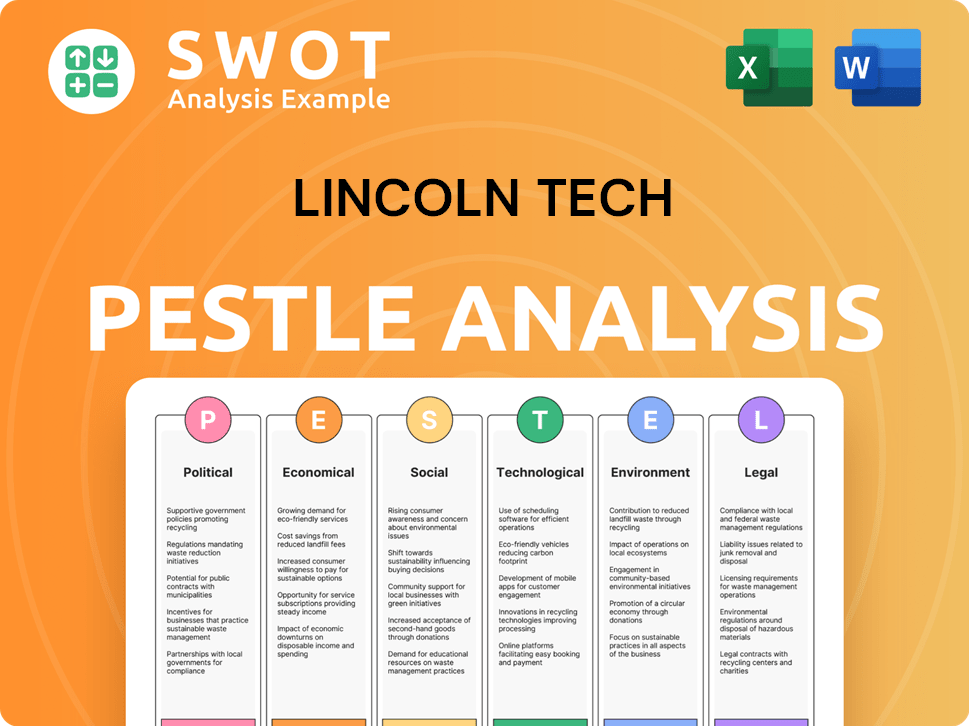
What Is Lincoln Tech’s Growth Forecast?
The financial outlook for Lincoln Tech, also known as Lincoln Educational Services, appears robust, underscored by strong performance in Q1 2025 and optimistic projections for the future. The company's strategic initiatives and focus on career training programs are driving growth, as evidenced by increasing revenue and student enrollment. This positive trajectory suggests a promising future for the institution and its stakeholders.
Lincoln Tech's financial health is further supported by its prudent financial management. The company's strong liquidity position and lack of debt provide a solid foundation for its expansion plans and investments in new programs and campuses. This financial stability is crucial for navigating the competitive landscape of technical education and vocational schools.
The company's financial performance in Q1 2025 demonstrated significant growth. Revenue reached $117.5 million, a 16.2% increase year-over-year. Adjusted EBITDA rose to $10.6 million, a 56% increase compared to Q1 2024. Net income also saw a substantial increase, reaching $1.9 million, up $2.2 million year-over-year. These results reflect the effectiveness of Lincoln Tech's growth strategy and its ability to capitalize on the demand for skilled workers.
In Q1 2025, revenue increased by 16.2% year-over-year, reaching $117.5 million. This growth indicates strong demand for Lincoln Tech's programs and effective marketing strategies. The increase in revenue is a key indicator of the company's success in the competitive market of career training programs.
Adjusted EBITDA for Q1 2025 was $10.6 million, a 56% increase from the same period in 2024. This significant growth in profitability reflects improved operational efficiency and effective cost management. The rise in EBITDA highlights the company's ability to generate strong returns.
Student starts, a key indicator of future revenue, grew by 20.9% to 4,610 in Q1 2025. This increase in student enrollment demonstrates the growing appeal of Lincoln Tech's programs. The rise in student starts is a positive sign for the company's long-term growth prospects.
The average student population increased to 15,469, a 16.2% year-over-year growth. This increase in student population reflects the company's ability to attract and retain students. This growth in student numbers is a critical factor in the company's financial performance.
Based on the strong Q1 performance, Lincoln Tech has provided optimistic guidance for 2025. The company projects revenue between $485 million and $495 million and adjusted EBITDA between $58 million and $63 million. They anticipate student starts to grow by 10% to 14% in 2025. These projections indicate continued confidence in the company's ability to execute its growth strategy.
Lincoln Tech anticipates revenue between $485 million and $495 million for 2025. This projection reflects the company's confidence in its ability to maintain its growth trajectory. The revenue forecast is a key indicator of the company's financial health and future prospects.
The company projects adjusted EBITDA between $58 million and $63 million for 2025. This projection demonstrates the company's commitment to profitability and operational efficiency. The EBITDA forecast is a key indicator of the company's financial performance.
Lincoln Tech expects student starts to grow by 10% to 14% in 2025. This anticipated growth in student enrollment is a positive sign for the company's long-term prospects. The student starts growth is a key indicator of the company's ability to attract and retain students.
Capital expenditures for 2025 are planned at $70-75 million, with $60 million allocated to new/relocated campuses and new programs. These investments support the company's expansion plans. The capital expenditures are a key part of the company's growth strategy.
Looking ahead to 2027, Lincoln Tech aims for revenue of $550 million and adjusted EBITDA of $90 million, representing a 16% margin. This translates to net income of approximately $36 million and earnings per share of around $1.13. These targets reflect the company's long-term goals and growth strategy.
The company ended 2024 with nearly $100 million in total liquidity and no debt outstanding. This strong financial position provides a solid foundation for future growth. This strong financial position supports the company's expansion plans.
For 2027, Lincoln Tech has set ambitious targets, aiming for $550 million in revenue and $90 million in adjusted EBITDA, representing a 16% margin. This would result in approximately $36 million in net income and earnings per share of about $1.13. Capital expenditures for 2025 are planned at $70-75 million, with $60 million allocated to new or relocated campuses and new programs. The company's strong financial position, with nearly $100 million in total liquidity and no debt at the end of 2024, supports these growth initiatives. For a deeper understanding of the company's marketing strategies, you can explore the Marketing Strategy of Lincoln Tech.
Lincoln Tech Business Model Canvas
- Complete 9-Block Business Model Canvas
- Effortlessly Communicate Your Business Strategy
- Investor-Ready BMC Format
- 100% Editable and Customizable
- Clear and Structured Layout
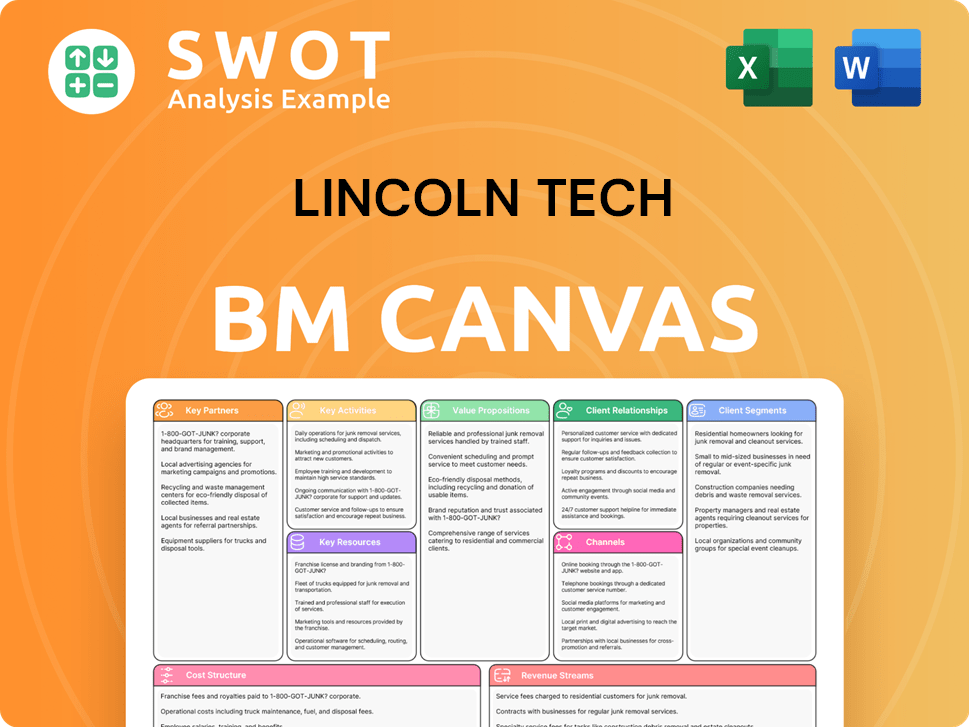
What Risks Could Slow Lincoln Tech’s Growth?
While the outlook for Lincoln Tech appears promising, several potential risks and obstacles could impact its growth trajectory. These challenges range from intense competition within the career training sector to the need for continuous adaptation to technological advancements. Successfully navigating these hurdles is crucial for realizing Lincoln Tech's long-term goals and maintaining its position in the market.
Understanding these potential pitfalls is essential for a comprehensive evaluation of Lincoln Tech's future prospects. A proactive approach to risk management, encompassing strategic planning and operational agility, will be key to mitigating these challenges. This includes staying ahead of industry trends and maintaining a strong focus on student outcomes.
The postsecondary career education sector is highly competitive. Even though Lincoln Tech is a leading provider of automotive and skilled trade graduates in the eastern United States, its estimated market share of around 1.9% across key programs highlights the competitive landscape. This necessitates a focus on differentiation and maintaining a competitive edge.
As a for-profit institution, Lincoln Tech is subject to evolving regulations and governmental policies. Changes in federal financial aid programs or accreditation standards could significantly impact enrollment and revenue. The company's CEO has actively discussed lobbying efforts to navigate regulatory changes.
The rapid evolution of technologies, such as AI and automation, poses a dual challenge. Continuous investment in curriculum development and equipment is necessary to ensure graduates remain competitive. Failure to adapt quickly to technological shifts could lead to a skills mismatch and decreased student demand for their career training programs.
Attracting and retaining qualified instructors in highly specialized fields can be a challenge, potentially limiting expansion. The company's reliance on new campus development and program replication requires careful management of human capital and infrastructure. Effective capital allocation and operational efficiency are also crucial.
Supply chain disruptions for specialized equipment or resources could impact the delivery of hands-on training programs. This could affect the quality of education and student outcomes. Diversifying suppliers and maintaining adequate inventory levels can help mitigate these risks.
While the company has a strong balance sheet with nearly $100 million in total liquidity and no debt, aggressive expansion plans could introduce financial risks. Careful financial planning and risk management are crucial to ensure sustainable growth. Monitoring enrollment trends and managing operational costs are vital.
The vocational schools sector is highly competitive, with numerous public and private institutions vying for students. Successfully differentiating Lincoln Tech from competitors is critical for attracting and retaining students. This includes offering specialized programs and strong industry partnerships.
Lincoln Tech Porter's Five Forces Analysis
- Covers All 5 Competitive Forces in Detail
- Structured for Consultants, Students, and Founders
- 100% Editable in Microsoft Word & Excel
- Instant Digital Download – Use Immediately
- Compatible with Mac & PC – Fully Unlocked
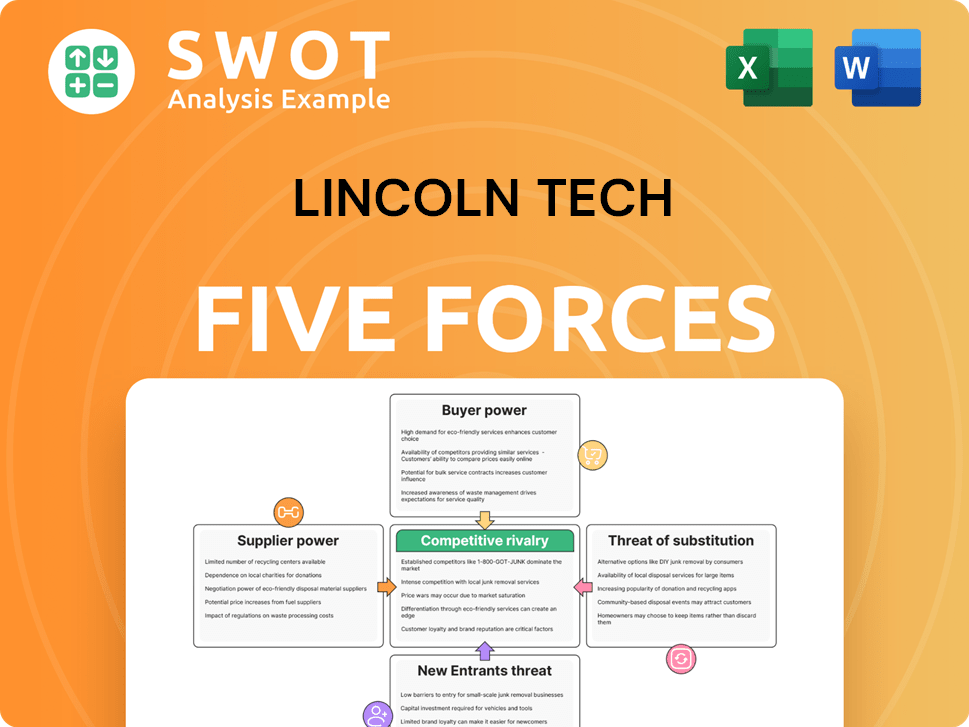
Related Blogs
- What are Mission Vision & Core Values of Lincoln Tech Company?
- What is Competitive Landscape of Lincoln Tech Company?
- How Does Lincoln Tech Company Work?
- What is Sales and Marketing Strategy of Lincoln Tech Company?
- What is Brief History of Lincoln Tech Company?
- Who Owns Lincoln Tech Company?
- What is Customer Demographics and Target Market of Lincoln Tech Company?
Disclaimer
All information, articles, and product details provided on this website are for general informational and educational purposes only. We do not claim any ownership over, nor do we intend to infringe upon, any trademarks, copyrights, logos, brand names, or other intellectual property mentioned or depicted on this site. Such intellectual property remains the property of its respective owners, and any references here are made solely for identification or informational purposes, without implying any affiliation, endorsement, or partnership.
We make no representations or warranties, express or implied, regarding the accuracy, completeness, or suitability of any content or products presented. Nothing on this website should be construed as legal, tax, investment, financial, medical, or other professional advice. In addition, no part of this site—including articles or product references—constitutes a solicitation, recommendation, endorsement, advertisement, or offer to buy or sell any securities, franchises, or other financial instruments, particularly in jurisdictions where such activity would be unlawful.
All content is of a general nature and may not address the specific circumstances of any individual or entity. It is not a substitute for professional advice or services. Any actions you take based on the information provided here are strictly at your own risk. You accept full responsibility for any decisions or outcomes arising from your use of this website and agree to release us from any liability in connection with your use of, or reliance upon, the content or products found herein.